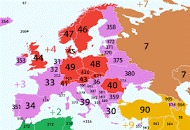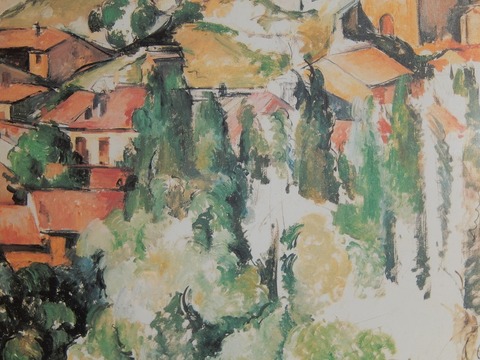Question 5: Track & trace
A manufacturer could place 8 tractor tires or 10 truck tires into a container for shipping. In one shipment, he sent a total of 96 containers. If there were more tractor tires than truck tires, how many tires did he ship?
Answer: Acknowledging the point about mixed containers (see impressive Solutions below), the answer to this tricky teaser was 852 & 768. Very well done to: Andrew Knox, Rubbond International, Ohé en Laak, The Netherlands; Michele Girardi, Scame Mastaf Spa, Suisio, Italy; Trevor Elison, manufacturing engineer, Mountville Rubber Co., LaGrange, Georgia, USA; David Mann, key account manager, SPC Rubber Compounding, UK; Dr Katharina Gottfried, TSAD manager, Arlanxeo Deutschland GmbH, TSAD EMEA II, Koeln, Germany; and everyone else who had a go.
Solutions:
Andrew Knox
To comply with the stipulations stated here, it is assumed that mixed containers are not allowed.
We are also not told that the manufacturer is attempting to maximise the number of tyres shipped. There is therefore not a unique answer to this question.
So if there are X containers of 8 tractor tyres and Y containers of 10 truck tyres, then X + Y = 96 and 8X > 10Y. These criteria are met by X is 54 or more.
If X = 54, total tyres shipped is (8 x 54) + (10 x 42) = 432 + 420 = 852 tyres.
If all 96 containers contain only tractor tyres, 768 tyres in total will be shipped.
For all other combinations of X > 54, the total number of tyres shipped will go down as X increases, but the criteria that there are more tractor tyre than truck tyres shipped will continue to be met.
Trevor Elison
Between 768 and 852 Tires Shipped
Containers_Tractor = C_F
Containers_Truck = C_T
C_F + C_T = 96
Rearranging
C_F = 96 – C_T
8*C_F > 10*C_T
Substituting
8(96 – C_T) – 10*C_T > 0
768 – 18*C_T > 0
768 > 18*C_T
42.67 > C_T
C_T = 42, 41 . . . 0
C_F = 96 – C_T = 54, 55, . . . 96
When C_T = 42, 420 Truck Tires and 432 Tractor Tires Shipped = 852 Total Tires
When C_T = 0, 0 Truck Tires and 768 Tractor Tires Shipped = 768 Total Tires
Michele Girardi
The total number of tires shipped is between 768 and 852 .
Calling x the number of tractor tire containers, the number of tractor tires is 8x, of truck tires is (96-x)*10 .
More tractor tires than truck tires means
8x > (96-x)*10
8x > 960 -10x
18x > 960
x > 960/18 = 53.8
x >= 54
corresponding to 54*8+(96-54)*10 = 852 tires
increasing the tractor tires to the maximum, for x = 96 the total is 96*8 = 768
So, the total number of tires is between 768 and 852
David Mann
For the numbers to be about equal, the containers would be in the ratio (10/18):(8/18), making 53.33:42.67 for 96 containers.
To have just more tractor tyres, the numbers would be:
54 tractor containers = 432 tyres
42 truck tyre containers = 420 tyres
So 852 in all.
Dr Katharina Gottfried
With x = tractor and y = truck:
8x>10y
x+y=96
Solving the equations:
x>53,3333
y<42,6667
With 54 containers full with tractor tires (=432) and 42 containers full with truck tires (=420), in total 852 tires has been shipped.
Going to next container pairs (55 tractors + 41 trucks; 56 tractors + 40 trucks) the total sum of tires is -2 each (850, 848, …).
New teaser on Monday
Question 4: Keep it country II
Fill in the gap in this sequence:
… Switzerland, Austria, __, Denmark, Norway, Poland…
Clues: 00
Answer: A technical blip with this one (apologies) prevented us adding Sweden (46) as an additional clue – so that can also be accepted as well as the official answer UK (44). Very well done to the highly select set of Brianiacs who recognised this sequence: Michele Girardi, Scame Mastaf Spa, Suisio, Italy; John Bowen, rubber industry consultant, Bromsgrove, Worcs, UK; Serafina Vulcano, Martinello Articoli Tecnici SpA, Italy; Andrew Knox, Rubbond International, Ohé en Laak, The Netherlands; Jose Padron, material development specialist, Waterville TG Inc. Waterville, Québec, Canada: and everyone else who had a go.
Solutions
Michele Girardi
These countries are ordered by international dialling code ; Switzerland (41), Austria (43), __, Denmark(45), Norway(47), Poland(48) .The missing one is UK (44)
John Bowen
Missing one is United Kingdom:
Dialing codes are
Switzerland 41
Austria 43
UK 44
Denmark 45
Norway 47
Poland 48
Andrew Knox
History repeats itself here with a list of European country dialling codes in ascending order, i.e. … Switzerland (41), Austria (43), __, Denmark (45), Norway (47), Poland (48)…
The gap is therefore filled by UK (44).
One wonders however why Sweden (46) is missing in this sequence?
I still quite like [another] answer, however, that this is a list of the founder members in of the European Free Trade Association (EFTA) – the missing countries in 1960 being Portugal, Sweden and the United Kingdom.
So, the answer could be Portugal, Sweden and the United Kingdom.
Jose Padron

Question 3: Particle science
Particle X passes through point P with velocity 2.8 m s−1 and constant acceleration 0.12 m s−2. Three seconds later particle Y passes through P with velocity 2.4 m s−1 and constant acceleration 0.2 m s−2. What is the distance from P when the two particles meet?
Clues: Clues: This equation of motion might help: s = ut + 0.5 (a x t squared)
(Where s = distance, u + initial velocity, v= velocity at time t, a = acceleration and t= time.)
Answer: Our questions usually garner a handful of replies within a couple of hours. Not so with this one, which held out for almost a day before the first correct answer arrived in. Extra well done so, in order of reply, to: Michele Girardi, quality manager, Scame Mastaf Spa, Suisio, Italy; Trevor Elison, manufacturing engineer, Mountville Rubber Co., LaGrange, Georgia, USA; Andrew Knox, Rubbond International, The Netherlands.
Solutions
Michele Girardi
The equation of motion applicable when the origin of time is zero are
S=S0+V0*t+1/2*a*t^2
V=V0+a*t
After 3 seconds , X will have reached the position and speed
Sx = 2.8*3+1/2*0.12*3^2 = 4.54
Vx= 2.8+0.12*3=3.16
Let's take t=0 when Y is in P , the equations of motion are
X : S = 4.54+3.16*t+1/2*0.12*t^2
Y: S = 2.4*t+1/2*0.2*t^2
the time at which the particles will have the same position is given by
4.54+3.6*t+1/2*0.12*t^2=0+2,4*t+1/2*0.2^t^2
whose meaningful solution is t=27.2s , corresponding to a distance of 139.4m
Trevor Elison
Particles meet 140m from point P
Assume both particles are on the same path.
Assume both accelerations are measured with the same accuracy. (.2= .20 m/s^2)
- Solve for s_x at 3.0 seconds = 8.94m
- Solve for v_x at 3.0 seconds = 3.16m/s (v_x,3 = u_x + a_x*t)
- Set s_x,f = s_y,f at time final (t_f)
- Rearrange to format ax^2 + bx + c = 0
a = (a_y-a_x)/2, b = (u_y – v_x,3), c = -s_x,3 (.04, -.76, -8.94)
- Solve for t_f using the quadratic formula = 27.22s (from the time Y passes point P)
- Substitute t_f into either distance equation (at the time Y passes point P) to obtain distance where the two particles meet
- 139.3659m. Round for significant figures = 140m
Andrew Knox
Distance from point P when the two particles meet (assuming they are travelling in exactly the same direction!) is approx. 139.27 m, time elapsed for particle Y is approx 27.2 s after passing point P.
Calculation: Distance travelled by particle X in its 3 second "head start" is v.t + (1/2) a.t.t, so distance = 2.8.t + 0.06.t.t or 8.94 m.
Its velocity after 3 seconds is 2.8 + 0.12x3 = 3.16 m/s.
So the distance travelled from point P by X, from the moment Y passes point P, is Dx = 8.94 + 3.16T + 0.06 t.t
This needs to equate to the distance travelled from point P by particle Y which is Dy = 2.4.t + 0.1.t.t.
The two particles meet when Dx = Dy, so solve for t = ca. 27.2 s, and Dx & Dy are then both equal ca. 139.27 m.
New, slightly easier, teaser on Monday.
Question 2: What comes next?
08 Friday, 12 Wednesday, 16 Monday, 20 Saturday, ?...
Answer: 24 Thursday ie the next ‘leap day’ on the calendar, 29th February 2024 – though some of our Brainiacs avoided all that and went straight down the maths route. Very well done, in order of reply, to: John Bowen, rubber industry consultant, Bromsgrove, Worcs, UK; Andrew Knox, Rubbond International, Ohé en Laak, The Netherlands; Stephan Paischer, head of product management special products, Semperit AG Holding, Vienna; David Mann, key account manager, SPC Rubber Compounding, UK; France Veillette, chef environnement, Usine de Joliette, Bridgestone Canada Inc., Canada; Suman Dhar, deputy general manager- international business at zinc chemicals producer Rubamin Private Ltd, Vadodara, Gujarat, India; Michele Girardi, Scame Mastaf Spa, Suisio, Italy; John Coleman, membership manager, Circol ELT, Dublin, Republic of Ireland. And, an extra well done to those – you know who you are! – who took the leap-year route.
New teaser on Monday.
Question 1: Percentage play
Complete this sequence:
O = 10%, ONE H = 40%, ONE HUND = 70%, ___.
Answer: You either got this one quite quickly or, perhaps, went on a ‘wild goose chase’. As explained nicely by David Mann and Michele Girardi (see Solutions below) below, the answer is ONE HUNDRED = 100%. Very well done, in order of reply, to: Stephan Paischer, head of product management and market intelligence, Semperit AG Holding, Vienna, Austria; David Mann, key account manager, SPC Rubber Compounding, UK; John Bowen, rubber industry consultant, Bromsgrove, Worcs, UK; Andrew Knox, Rubbond International, The Netherlands; Michele Girardi, quality manager, Scame Mastaf Spa, Suisio, Italy; Suman Dhar, deputy general manager- international business at zinc chemicals producer Rubamin Private Ltd, Vadodara, Gujarat, India; John Coleman, membership manager, Circol ELT, Dublin, Republic of Ireland; Serafina Vulcano, Martinello Articoli Tecnici SpA, Italy; and everyone else who had a go.
Solutions
David Mann
The sequence is
O
ONE
ONE HUND
ONE HUNDRED
and the percentages are the number of letters divided by the number of letters in ONE HUNDRED.
So the next term is ONE HUNDRED = 100%
Michele Girardi
Hello everybody, the answer is: ONE HUNDRED=100%, as can be seen from the following sequence:
O 1 letter 10%
ONE H 4 letters 40%
ONE HUND 7 letters 70%
ONE HUNDRED 10 letters 100%



